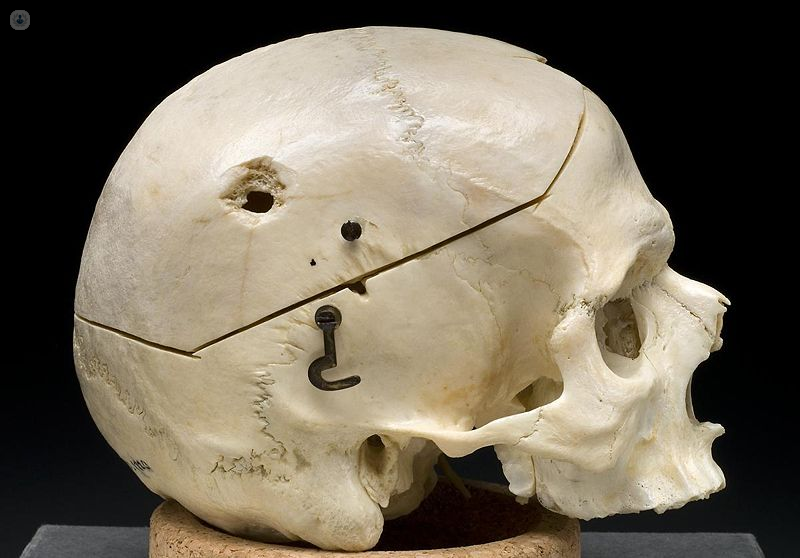

What is a skull fracture?
A skull fracture consists mainly of the breaking of one or more bones of the head. In fact, a skull fracture not only causes a fracture in the bone, but also causes injuries to veins and arteries, which can bleed near brain tissue. Nerve damage can also occur.

Skull fractures may or may not involve brain injury, although the fracture usually does not involve brain injury. Fractures, especially those at the back and base of the skull, can tear the meninges, the tissues that protect the brain.
There are different types of skull fractures:
- Linear: occurs on defined lines. It is usually a closed fracture that has no depressions or sprays and does not cut the skin.
- Composite: includes shards in the bone and goes through the skin. In this case, a fracture occurs in the skull, normally associated with brain damage.
- With sinking: in this case the skull sinks, pressing on the brain.
- Basal: the fracture is at the base of the skull and is normally located around the eyes, nose, or skull base near the spine.
Prognosis
The prognosis for the injury is generally positive as long as there is no brain damage. Fractures in the skull are usually slight, with minimal treatment being necessary, consisting simply of solving wound problems and assessing the patient's neurological status. However, in the case of brain damage, the consequences can be severe, such as permanent disability.
Symptoms of a skull fracture
Symptoms of a skull fracture may include the following:
- Bleeding, which may be from the wound or from the nose, ears, or around the eyes
- Bruising under the eyes or ears
- Change in pupil size
- Confusion
- Seizures
- Balance problems
- Drowsiness
- Migraine and headache
- Loss of consciousness
- Exceptionally stiff neck
- Problems on speaking and pronouncing
- Nausea and vomiting
- Motor difficulties
- Visual disturbances
Medical tests for skull fracture
Skull fractures are usually diagnosed by computed tomography (CT) scans. In this case, this test is better than magnetic resonance imaging (MRI).
What causes a skull fracture?
The causes of head injuries and, therefore, injuries involving a fractured skull are usually the result from impacts, blows or shocks to the head. These occur in traffic accidents, playing sports, etc.
In children, the skull fracture is caused in most cases by a fall, for example during playing, cycling, rollerblading, and so on. It is estimated that more than half of fractures in children are caused by falls. In the case of adults, falls are also a frequent cause, although incomparable to the case of those over 65 years of age, in which more than 80% of skull fracture cases are caused by a fall.
The second cause of these injuries is an accident in which a heavy or forceful element ends up impacting the patient's head, such as a golf ball, a falling debris... In this case, the trauma or accident is severe, so it overcomes the elasticity of the skull bones, breaking them and causing the fracture.
A car accident is the third leading cause of this condition, although brain damage from a car accident is usually very severe.
Can it be prevented?
A skull fracture cannot be prevented because it is caused by an accident or trauma. However, there are useful measures that can help to keep the individual protected. Some of them are:
- Using seat belts and special child seats in cars
- Wear a helmet when doing sports such as climbing or contact sports. Helmet should be worn when riding a bicycle or motorcycle
- Wear special protective equipment for each sport
Treatments for skull fractures
Patients with a skull fracture but no brain injury are admitted to the hospital to monitor their condition and progress. It should be noted that most skull fractures do not require specific treatment, except for depression fracture, base skull fracture and compound fracture.
In the case of a fracture involving a sinking fracture, the bone or skull fragments press on the inner part of the brain, and it can be injured. In turn, a part of the brain is exposed to the outside, allowing abscesses and infection to form in the area. Foreign materials and dead tissue should be removed and the wound treated as much as possible. Subsequently, the sunken skull will be lifted and placed in place, suturing the wound and beginning to observe the patient's progress.
In skull base fractures, the patient should be placed at rest with the head raised, waiting for the leakage of cerebrospinal fluid to stop. If the meninges are torn, they usually close by themselves within two days to a week after the trauma. If the flow of cerebrospinal fluid does not stop, the specialist may try to remove it by inserting a small needle into the lower back. If it cannot be removed with the needle, the specialist may choose to begin removal surgery.
